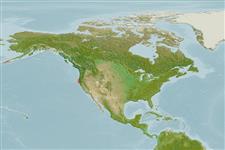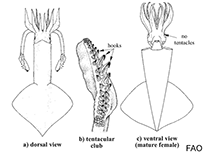Onykia robusta (Verrill, 1876)
Robust clubhook squid| Native range | All suitable habitat | Point map | Year 2050 |

|
| This map was computer-generated and has not yet been reviewed. |
| Onykia robusta AquaMaps Data sources: GBIF OBIS |
Google image | No image available for this species;
drawing shows typical species in Onychoteuthidae.
Classification / Names Tên thường gặp | Các synonym ( Các tên trùng) | CoL | ITIS | WoRMS
Cephalopoda | Oegopsida | Onychoteuthidae
Environment: milieu / climate zone / Mức độ sâu / distribution range Sinh thái học
Tầng nổi; Mức độ sâu 32 - 528 m (Tài liệu tham khảo 101455). Subtropical; 61°N - 36°N, 145°E - 126°W (Tài liệu tham khảo 275)
Distribution Các nước | Các khu vực của FAO | Các hệ sinh thái | Những lần xuất hiện | Những chỉ dẫn
Northern Pacific and the Arctic. Subtropical to polar.
Length at first maturity / Bộ gần gũi / Weight / Age
Chín muồi sinh dục: Lm ? range ? - ? cm Max length : 200 cm ML con đực/không giới tính; (Tài liệu tham khảo 275); common length : 160 cm ML con đực/không giới tính; (Tài liệu tham khảo 97142); Khối lượng cực đại được công bố: 50.0 kg (Tài liệu tham khảo 275)
Life cycle and mating behavior Chín muồi sinh dục | Sự tái sinh sản | Đẻ trứng | Eggs | Sự sinh sản | Larvae
Main reference
Các tài liệu tham khảo | Người điều phối | Người cộng tác
MarineSpecies.org 2050 MarineSpecies.org. http://www.marinespecies.org/index.php (Tài liệu tham khảo 3477)
IUCN Red List Status
(Tài liệu tham khảo 130435: Version 2025-1)
CITES status (Tài liệu tham khảo 108899)
CMS (Tài liệu tham khảo 116361)
Threat to humans
Human uses
Các nghề cá: có khả năng có lợi
| FishSource |
Các công cụ
Thêm thông tin
Max. ages / sizes
Length-weight rel.
Length-length rel.
Length-frequencies
Mass conversion
Sự phong phú
Các nguồn internet
BHL | BOLD Systems | CISTI | DiscoverLife | FAO(Publication : search) | Fishipedia | GenBank (genome, nucleotide) | GloBI | Gomexsi | Google Books | Google Scholar | Google | PubMed | Cây Đời sống | Wikipedia (Go, tìm) | Tạp chí Zoological Record



